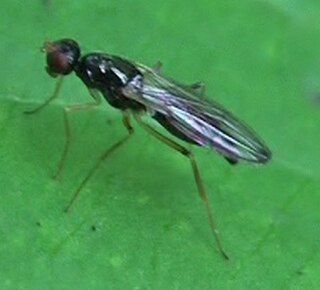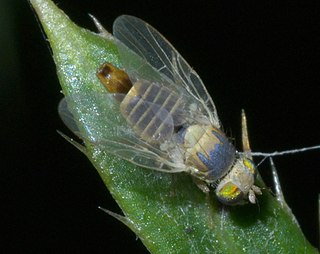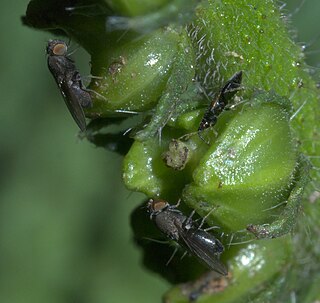
The Drosophilidae are a diverse, cosmopolitan family of flies, which includes species called fruit flies, although they are more accurately referred to as vinegar or pomace flies. Another distantly related family of flies, Tephritidae, are true fruit flies because they are frugivorous, and include apple maggot flies and many pests. The best known species of the Drosophilidae is Drosophila melanogaster, within the genus Drosophila, also called the "fruit fly." Drosophila melanogaster is used extensively for studies concerning genetics, development, physiology, ecology and behaviour. Many fundamental biological mechanisms were discovered first in D. melanogaster. The fruit fly is mostly composed of post-mitotic cells, has a very short lifespan, and shows gradual aging. As in other species, temperature influences the life history of the animal. Several genes have been identified that can be manipulated to extend the lifespan of these insects. Additionally, Drosophila subobscura, also within the genus Drosophila, has been reputed as a model organism for evolutionary-biological studies, along with D. sechellia for the evolution of host specialization on the toxic noni fruit and Scaptomyza flava for the evolution of herbivory and specialist on toxic mustard leaves.

The Ulidiidae or picture-winged flies are a large and diverse cosmopolitan family of flies (Diptera), and as in related families, most species are herbivorous or detritivorous. They are often known as picture-winged flies, along with members of other families in the superfamily Tephritoidea that have patterns of bands or spots on the wings. Some species share with the Tephritidae an unusual elongated posteroapical projection of the anal cell in the wing, but can be differentiated by the smoothly curving subcostal vein. Two species, Tetanops myopaeformis and Euxesta stigmatias, are agricultural pests.

Canacidae, incorrectly Canaceidae, or beach flies, surf or surge flies, is a family of Diptera. As of 2010, 307 species in 27 genera. The family now includes Tethininae as a subfamily.
Gobryidae is a monotypic family of flies containing the genus Gobrya, described by Francis Walker in 1860. They are relatively rare and found in Southeast Asia, Taiwan, Indonesia, Malaysia, the Philippines, and New Guinea. Gobryids are often metallic in coloration and their heads are wider than the rest of their bodies. Very little is known about the larval habits of these flies. McAlpine (1997) elevated the genus to family level. More research is needed to determine the best phylogenetic placement for Gobrya.

The Pyrgotidae are an unusual family of flies (Diptera), one of only two families of Cyclorrhapha that lack ocelli. Most species are "picture-winged", as is typical among the Tephritoidea, but unlike other tephritoids, they are endoparasitoids; the females pursue scarab beetles in flight, laying an egg on the beetle's back under the elytra where the beetle cannot reach it. The egg hatches and the fly larva enters the body cavity of the beetle, feeding and eventually killing the host before pupating. In the United States, some species of Pyrgota and Sphecomyiella can be quite common in areas where their host beetles are abundant. Like their host beetles, these flies are primarily nocturnal, and are often attracted to artificial lights.

The Strongylophthalmyiidae are a small family of about 80 species of slender, long-legged flies, the majority of which occur in the Oriental and Australasian regions. They are divided into two genera, the monotypic Southeast Asian genus Nartshukia Shatalkin, 1993 and Strongylophthalmyia Heller, 1902. The relationships of the group are obscure; formerly the genus Strongylophthalmyia was classified with the Psilidae, and some recent classifications place it within the Tanypezidae. Little is known of their biology, but many species seem to be associated with rotting bark.

The Richardiidae are a family of Diptera in the superfamily Tephritoidea.
Cecidochares is a genus of tephritid or fruit flies in the family Tephritidae.

Oxyaciura is a genus of tephritid or fruit flies in the family Tephritidae.

Euphranta is a genus of fruit flies in the family Tephritidae. There are at least 90 described species in Euphranta.

The Ulidiinae are a subfamily of flies in the family Ulidiidae. Like the Otitinae, most species are herbivorous or saprophagous. Most species share with the Tephritidae an unusual elongated projection of the anal cell in the wing but can be differentiated by the smoothly curving subcostal vein. Most are dull gray to shiny brown or black flies with vein R1 setulose or, in a few cases, bare.

Platystoma is a genus of flies (Diptera) belonging to the family Platystomatidae.
Goniurellia is a genus of tephritid or fruit flies in the family Tephritidae.
Tephritopyrgota is a genus of flies in the family Pyrgotidae.

Terelliini is a tribe of fruit flies in the family Tephritidae. There are at least six genera and about 104 described species in Terelliini.

Gymnomyzinae is a subfamily of shore flies in the family Ephydridae.

Curtonotum is a genus of flies in the family Curtonotidae. There are more than 50 described species in Curtonotum.
Aldrichiomyza is a genus of freeloader flies in the family Milichiidae.
Chyliza leguminicola is a species of rust flies in the family Psilidae.














